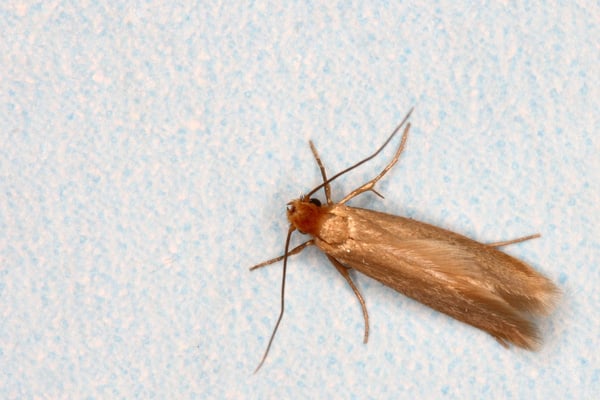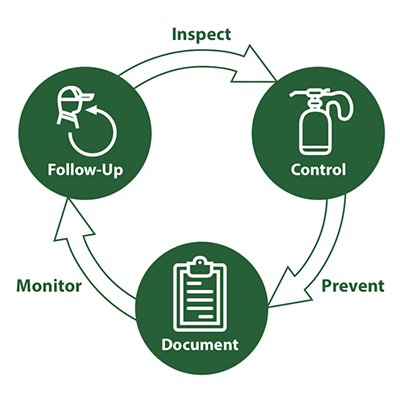Webbing Clothes Moth
Appearance And Behavior
Webbing clothes moths (Tineola bisselliella) are the most frequently-encountered clothing moth in the US. The common name of this stored product pest references the fact that their larvae produce silk webbing. The moth larvae tend to spread this webbing all over whatever they’re feeding on, which is usually clothing.
Webbing clothes moths are established pests all over the world. Pretty much wherever people live, webbing clothes moths live.
Webbing clothes moths measure about 1/2" long from wing tip to wing tip. Their wings are long, narrow, and golden or beige-colored. Adult moths have a distinctive tuft of red scales at the top of their heads.
Mature webbing clothes moth larvae is around 1/2" long. They’re mainly white, with brownish heads. Like other caterpillar larvae, they appear to have definite, distinct body segments.
Webbing clothes moths’ total development time (from egg to adult) depends largely on environmental conditions. In ideal, warm environments, a moth’s life cycle may complete in one month. In colder conditions, moths could remain larvae for over a year. Like other moths, webbing clothes moths undergo full metamorphosis from egg to caterpillar to adult. The caterpillar, or larval, stage is the stage that actually damages clothing.
Female webbing clothes moths lay an average of 40 to 50 eggs within their adult lifetime. These eggs hatch within four to ten days. Upon hatching, larvae immediately begin eating nearby food materials, producing silk, and molting. A single larvae may molt up to 45 times before reaching pupation. When larvae are ready to pupate, they move away from food and spin a silken cocoon for themselves. Upon emerging from this cocoon, the new adult begins mating and laying eggs immediately. Adult moths do not live very long after metamorphosis.

Webbing clothes moths really only feed on natural animal fibers. They will also feed on synthetic fibers interwoven with animal fiber, however. Practically, this means webbing clothes moths will infest keratin-containing materials such as wool, hair, fur, and more. They may also infest beef meal, fish meal, pemmican, casein, and milk products, fur, and more. When the larvae feed in exposed areas, they may spin a silken mat or patch and feed from beneath it.
During severe infestations, larvae may crawl about more openly. You could find them in closets, under furniture, or on other fabrics. Larvae prefer to live and develop in areas with high humidity. Contrary to popular belief, adult moths don’t actually feed. Unlike many moth species, webbing clothes moths also aren’t attracted to light. In fact, they tend to shun it to find dark, hidden feeding areas. Adult moths are poor fliers but can run quickly when they’re disturbed. If you encounter moths, they may attempt to flee from you to the nearest dark, hidden place.
Webbing Clothes Moth Prevention

Regularly clean and launder all garments that contain animal fibers. When you’re not actively wearing clothing, considering storing it in garment bags. If you rarely wear an article of clothing, you should store it in an airtight container. Refrigerated storage is the most effective way to keep moths away from fabric and other garments.
You should also regularly clean and launder upholstered furniture, blankets, carpets, and rugs comprised of wool. You should be especially thorough if you have a pet. Clean up pet hair very regularly and keep it from building up on clothing or furniture.
Webbing Clothes Moth Control Process
A Plunkett’s technician will start by thoroughly inspecting your home for sources of infestation. We’ll locate the areas where webbing clothes moths eat and reproduce in your home and clean them out. Then, we’ll figure out how the moths accessed these sites in the first place. We’ll make recommendations on how to seal access points and make minor repairs if applicable.
In some cases, Plunkett’s technicians may apply insecticide spot treatments in closets, cracks, crevices, and other vulnerable areas. These insecticides will help repel moths in the future and prevent breeding. Even after a professional treatment, continual inspection and regular cleaning are very important to prevent re-infestation.
If you think you have a webbing clothes moth problem, call Plunkett’s Pest Control right away. We’ll help keep your closet clean.

Moth Control With Plunkett's
At Plunkett’s, our goal is to help you quickly, conveniently, and in the most cost-effective way. We make every effort to be with you asap, usually within a day or two.
Learn More
There are a good number of stored product pests that are particularly likely to make pests of themselves around your home. Some of the most common examples of stored product pests Plunkett’s encounters frequently include:






